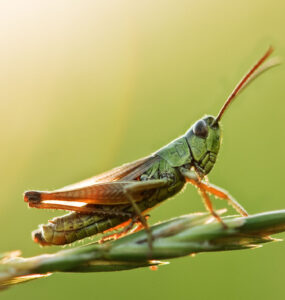Household Pests: Spider Mites
by Rob Sproule
Spider mites are a winter epidemic in Alberta thanks to our household air getting dry-as-toast. They thrive in warm, dry places and seem to be a February fixture on houseplants.
A member of the mite family, they get their nickname from the protective webbing they spin (they are less than a millimeter long after all). While they prefer some plants over others, they will do serious damage to anything they infest. The good news is that, with persistence, they are relatively easy to control.
In the yard they have many natural enemies, including lady bugs, which usually keeps their numbers in check (except they tend to pop up during long, hot droughts), but indoors we need to control them manually.
Spider Mite Life Cycle
When it comes to population booms, these varmints know all the tricks. Their eggs can hatch in 3 days. Offspring are sexually mature in 5 days and females will lay 20 eggs a day for their 4 week life cycle.
As bleak as the math is, there are solutions. I recommend against reaching for the chemical cure unless the situation is dire. Their short life cycle allows them to adapt easily to pesticides. If you use products like pyrethrum but don’t kill them all, they will develop resistance over time and magnify your troubles.
Spider Mite Damage
These nasty critters could easily be called Vampire mites. They feed by puncturing surface plant cell and suck the juices right out of them, leaving a weakened and, eventually, a dead plant behind.
Like vampires, they shun sunlight whenever possible and attack the undersides of the leaf first. By the time mite damage is obvious, it’s extensive, so try to catch it early.
Early signs include yellow discolorations on the leaf surface. Turn the leaf over and you’ll see tiny mites bustling about and, with a magnifying glass, you’ll be able to see their perfectly round eggs scattered randomly.
Signs of an extensive infestation are clumps of webbing around the leaves, red rusty spots turning to brown, and scores of creepy specks moving across the webbing in their dastardly work. As they suck the cells dry the leaves will droop, drop, and eventually the plant will die.
Killing Them
Imagine the tropics, and the relaxing sound of a warm, heavy afternoon rain splashing over broad tropical leaves. That rain is doing much more than providing white noise for napping; it’s a natural preventative for spider mites, which thrive on the dry tissue of partly desiccated leaves.
Just as dry leaves (ie. when you’ve only been watering the soil) attract spider mites, moist leaves repel them. When you see spider mites, all you need for your first offensive is a good spray bottle.
Spray the underside of every leaf vigorously with as strong a jet as you can get without damaging the leaf. Pay particular attention to the crooks where the leaf stem grows out of the main stem (the nodes). Lay some plastic around the plant’s base; your going to be spraying water and, hopefully, knocking scores of mites off the leaves as you go.
Take your time, and remember they covet shadows so get under every leaf. Hurrying things along will lead to missed mites and a soon-to-be rebounded population.
With this in mind, regularly misting the leaves will help keep a population from getting established, although it won’t do much against a raging outbreak. Regularly soaking your plants’ leaves down is ideal but also unrealistic in homes with hardwood floors or carpet.
Spray every few days and, if that’s not working, it’s time to try something more potent. Grab some insecticidal soap and spray it on (ease up on the jet spray this time). The soap is safe for you but clogs their pores; you’re basically tar and feathering them without the feathers.
Repeat the soapy spray every 3-5 days to make sure you catch the eggs after they’ve hatched and before they bred. The key to beating them is to match your spraying to their life cycle, and to be stubborn about it for a couple of weeks.
If the soapy water still doesn’t work, it’s time for the artillery. Look to neem oil or a pyrethrum based spray and follow the same cycle. If using pyrethrum, make sure to get all the bugs or they may build immunity.
You can turn to predators, which are readily available online, for an effective and organic solution. They can be pricey, however, and involve introducing another insect into your home.
















